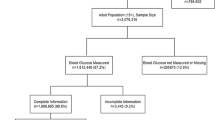Abstract
BACKGROUND: Obesity in childhood and adolescence is associated with health problems, increases in cardiovascular disease (CVD) risk factors and a greater likelihood of becoming overweight as an adult. A description of the sociodemographic distribution of overweight and obesity among children and adolescents in the population may allow us to determine if health promotion resources should be differentially allocated to particular groups.
METHODS: The New South Wales Schools Fitness and Physical Activity Survey, 1997 (n=5518) was a cross-sectional survey which measured height, weight, waist and hip girths and skinfold thicknesses of randomly selected New South Wales students in school years 4, 6, 8 and 10. Height and weight only were measured among Year 2 students. The mean ages of students in school years 2, 4, 6, 8 and 10 were 7.3 y, 9.3 y, 11.3 y, 13.3 y and 15.3 y, respectively. The values of body mass index (BMI), waist girth, waist-to-hip ratio (WHR) and sum of three skinfolds for students resident in urban and rural areas and in tertiles of socioeconomic status (SES) were compared.
RESULTS: There were no differences on any of the anthropometric measures between urban and rural boys and girls, with the exception that WHR was higher among urban girls. Among boys, there were no differences between the SES tertiles on any of the measures. Among girls, each of the anthropometric measures (except sum of skinfolds) was inversely associated with SES, with body fatness tending to be lower in the high SES tertile, compared with the low and middle SES tertiles. None of the statistical interactions between school year and body fatness was significant, suggesting that the relationship is consistent from childhood to adolescence.
CONCLUSION: On the basis of these results, we suggest that health promotion programs aimed at weight management among Australian girls of lower SES are not warranted. We recommend that health promotion programs emphasize regular physical activity, a healthy diet and acceptance of the normal range of body shapes.
This is a preview of subscription content, access via your institution
Access options
Subscribe to this journal
Receive 12 print issues and online access
$259.00 per year
only $21.58 per issue
Buy this article
- Purchase on Springer Link
- Instant access to full article PDF
Prices may be subject to local taxes which are calculated during checkout
Similar content being viewed by others
Author information
Authors and Affiliations
Corresponding author
Rights and permissions
About this article
Cite this article
Booth, M., Macaskill, P., Lazarus, R. et al. Sociodemographic distribution of measures of body fatness among children and adolescents in New South Wales, Australia. Int J Obes 23, 456–462 (1999). https://doi.org/10.1038/sj.ijo.0800841
Received:
Revised:
Accepted:
Published:
Issue Date:
DOI: https://doi.org/10.1038/sj.ijo.0800841
Keywords
This article is cited by
-
Determinants of obesity in Turkey: appetite or disease?
Journal of Public Health (2019)
-
Repeatability of self-report measures of physical activity, sedentary and travel behaviour in Hong Kong adolescents for the iHealt(H) and IPEN – Adolescent studies
BMC Pediatrics (2014)
-
Area-level deprivation and adiposity in children: is the relationship linear?
International Journal of Obesity (2013)
-
Outcomes of a group-randomized trial to prevent excess weight gain, reduce screen behaviours and promote physical activity in 10-year-old children: Switch-Play
International Journal of Obesity (2008)
-
Socioeconomic Status and Adiposity in Childhood: A Systematic Review of Cross‐sectional Studies 1990–2005
Obesity (2008)



